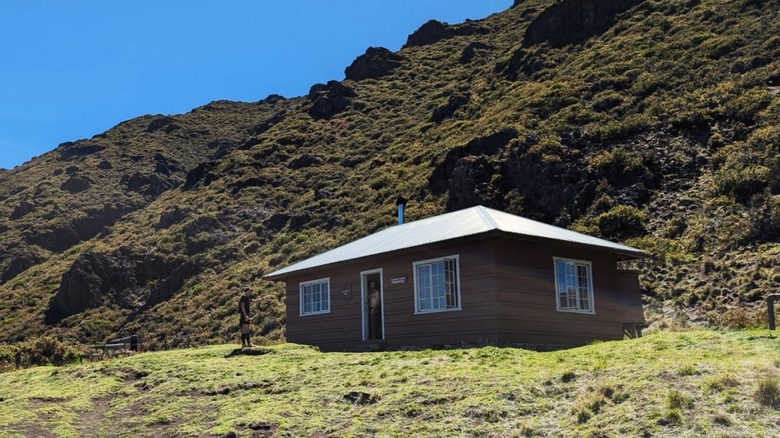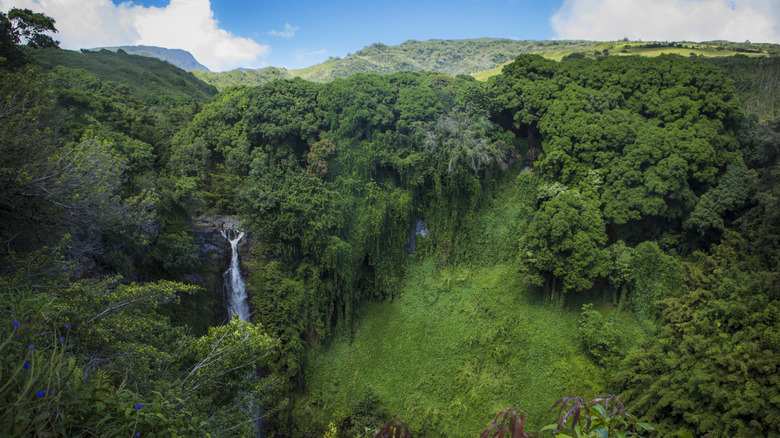Hawaii's Unique Wilderness Cabins Can Only Be Reached By Trail On The Slopes Of A Volcano
For some people, vacations are all about 5-star hotels, comfy beds, and room service. But for others, roughing it is part of the experience, and the journey to your final destination is half the story. If you belong to the second group, spending the night in the wilderness cabins at Hawaii's Haleakalā National Park is one of the best things you can do on your Maui vacation.
Lining the massive Haleakalā crater, these cabins are only accessible via backcountry trails. However, the strenuous hike is worth it for the opportunity to wake up in a rugged, volcanic environment as alien as it is beautiful. During the day, visitors can take hikes through the crater and to some of the park's most beautiful places, including Halalii cinder cone's austere peaks, which look as though they're painted in shades of burnt red and grey.
There are three cabins (Palikū, Kapalaoa, and Hōlua) spread out across the park, each with 12 bunk beds, a dining room table, a kitchen with a sink and basic utensils, picnic tables, a vault toilet, propane and wood stoves, and lockers where each hiker can find their allotment of wood. You must bring your own food, drinking water, sleeping bag, flashlight, first aid kit, and matches. Reservations can be extremely difficult to come by, but visitors can book cabin permits up to six months in advance via Recreation.gov. We recommend reserving your permits as early as possible; some people wait until midnight exactly six months before their desired date to ensure they get a reservation.
Everything to known about the wilderness cabins at Haleakalā National Park's
In order to reach the cabins, visitors must hike through rugged volcanic terrain, shrublands, blistering sun (and possible rain), and intense heat. Situated at 6,940 feet, Hōlua Cabin requires the shortest hike — 3.7 miles from the Halemauʻu Trailhead's tiny parking area — and is surrounded by native shrublands. Home to the nēnē (native Hawaiian goose), these shrublands teem with life, in stark contrast to the desolate areas near the bottom of the crater.
At an elevation of 7,250 feet, Kapalaoa Cabin is accessible via a 5.6-mile hike along the Keoneheʻeheʻe Trail (Sliding Sands), winding through dramatic volcanic rocks and into Haleakala's crater. The cabin is also a short distance from "Pele's Paint Pot," an alpine desert area known for its vividly colored volcanic landscape.
The final cabin is a bit further out and settled at the base of a cliff covered in dense rainforest foliage. Situated at 6,380 feet, Palikū Cabin is 9.3 miles from the summit via the Keoneheʻeheʻe Trail or 10.4 miles along the Halemauʻu Trail. Both trails are unshaded, and the terrain and high altitude will challenge your endurance. However, many campers consider it the best cabin in the park. Lush fern trees and grass surround the structure, while the stars appear unbelievably bright in a night sky devoid of light pollution.
Other things to do at Haleakalā National Park
Covering 30,183 acres, Haleakalā National Park is home to Haleakalā, Hawaii's third-largest volcano. In fact, with an elevation of over 10,000 feet, Haleakalā, which last erupted between 400 and 600 years ago, is one of the world's largest volcanoes. While many visitors arrive before dawn to shoot sunrise photography at Maui's Haleakala National Park, getting out on the crater trails or camping is the best way to experience "the quietest place on Earth."
Although the Keoneheʻeheʻe Trail features a peaceful, moon-like landscape, another can't-miss route is the 4-mile Pipiwai Trail in the green, waterfall-filled Kīpahulu District. The trail takes hikers past an ancient Banyan tree, through bamboo forests, and to the 400-foot Waimoku Falls.
Pipiwai Trailhead is located steps from Kīpahulu Campground, which offers 20 oceanfront campsites along the scenic Road to Hana. Although nowhere near the summit, the campground provides easy access to the Pools of 'Ohe'o (the Seven Sacred Pools), a series of swimmable pools connected by waterfalls along the Palikea Stream. On the other hand, conveniently located at the end of Hosmer Grove Access Road, Hosmer Grove Campground offers six tent-only campsites on a grassy hill found just minutes from the Visitor Center, allowing campers to beat the crowds of sunrise chasers at the summit. The weather in this area is often rainy, and you should expect temperatures below zero at night.
Looking for something else to do once you're done roughing it in Haleakalā National Park? Reward your hard work with an evening at one of the best luaus in Maui.


